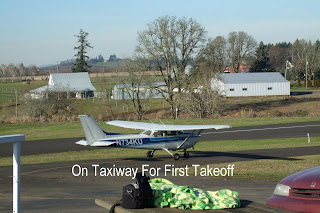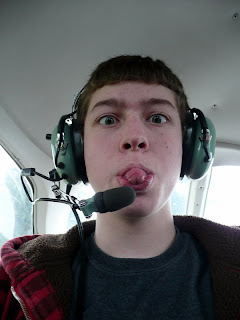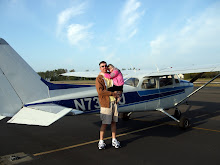
1.5hrs - Navigation to three local airports, hood time, towered airport, and a few firsts.
It started out as a very foggy day, with visibility of .5sm or less in many areas, but being optimistic I completed the flight plan for our trip to three local airports. Fortunately by the time my lesson was scheduled for, the fog had cleared for all but one of the three airports we would be visiting.
Prior to leaving we called for a weather briefing, which I had not done before. It’s much easier using DUATs online, but I can see where internet access is not always going to be an option. The pace that the information was given was a little fast for my novice understanding, and my ear-hand coordination suffered, leaving me with a note page resembling something copied down by the house cat.
First stop was McMinnville (MMV). I’ve flown to McMinnville many times now during my training, and know the way by looking out the window, but this time I followed the compass heading I’d determined. It actually worked, and I wound up right where I was supposed to. We entered the pattern for a touch and go, and off to Aurora (UAO).
We followed my predetermined compass heading and wind correction, arriving directly at Aurora.
Cool, two for two.
Since it was quiet at Aurora, we made a straight in approach, which I’d never done before. On a straight approach you are lined up with the runway a few miles out, and remain so during the descent, rather than entering the pattern on downwind, and making a turn to base, and a turn to final. The advantage to this type of approach is that it's quick if you are already inbound on the runway heading. The disadvantage is that it is more difficult to see other aircraft in the pattern, and more difficult for them to see you. Anyway, at first it felt way out of sorts because my key points in the pattern were not available, but soon began to look familiar, and one touch and go for Aurora.
After departing Aurora I did some time under the hood. The "hood" is a view limiting device that limits your field of vision to only the instruments.
This was my first experience in the air with reference only to instruments (I had done .7hrs with a simulator). I can’t even read a book as a passenger in a car, so this felt very unnatural.
We did several standard rate turns to a heading, climbs, descents, and climbing and descending turns. We also did several standard rate turns with the heading indicator covered, counting the seconds, rolling out of the turn, and checking the heading. A standard rate turn, also called a two minute turn, will result in a 360 degree turn in two minutes, or three degrees per second.
I flew around for half an hour without being able to look out the window, and without getting sick or needing more than just a little guidance. Not too bad. It is surprisingly tiring though, and very difficult to not follow what your sense of balance is telling you.
Our original third destination, Mulino, was still fogged in, but it was a great day, and we still had time, so our next stop would be Hillsboro (HIO).
Hillsboro is towered, which was also a first in my training. We were cleared for a touch and go, as well as right traffic for a second touch and go. I’d not flown a right pattern yet (all pattern turns to the right). It was not really any more difficult, just different.
After the second touch and go at Hillsboro, we were off to home. On downwind my instructor pulled the throttle to practice an engine out landing.
Had this been an actual emergency, it would have been a bummer...
I was too high and fast, tried slipping but that maneuver definitely needs work, and ended up practicing a go-around instead.
The second time around with no power was right on, and ended the lesson on a nice note.
Next lesson is a cross country of more than 50nm. If the weather is good (could be, according to current forecasts), Newport (ONP) is the destination. I know the goal is to learn how to navigate safely from point A to point B, but I can’t help looking forward to this just for the experience of flying to a place that I know and enjoy very much from the ground. If that doesn’t work out, there are a few options down the Willamette valley that should be interesting as well.














